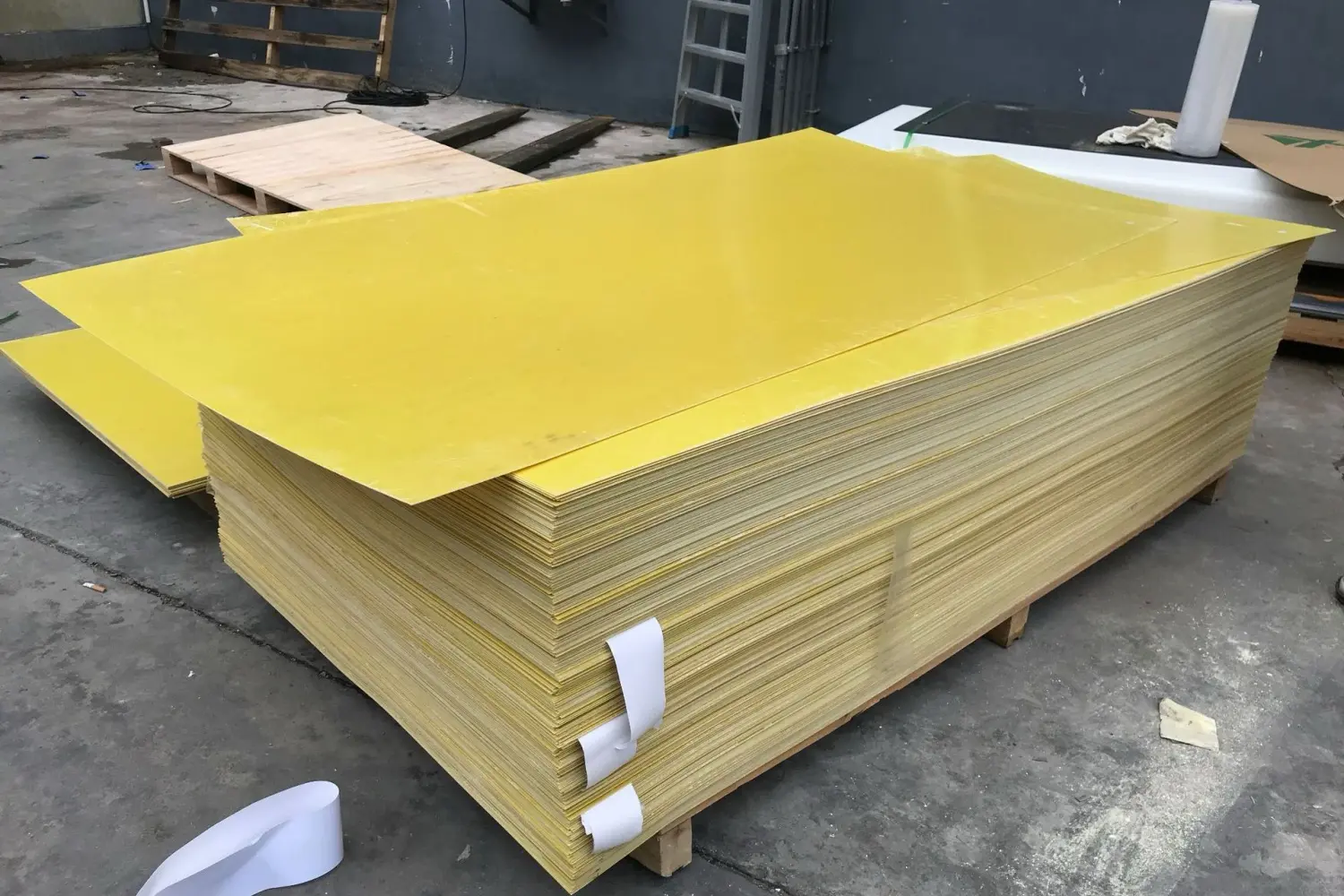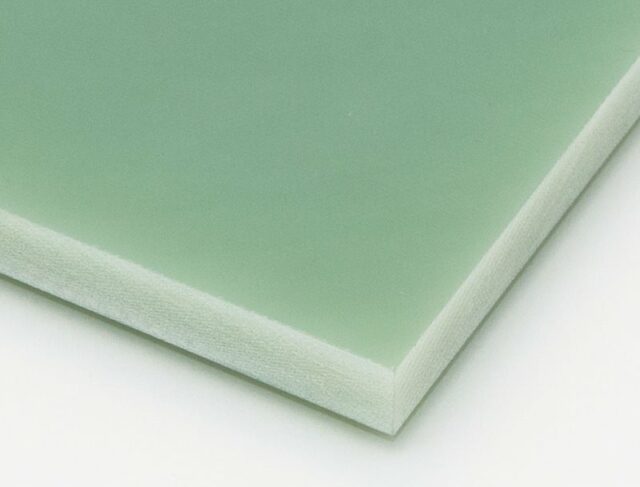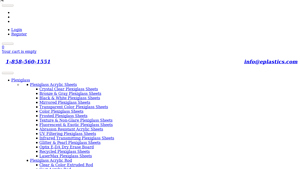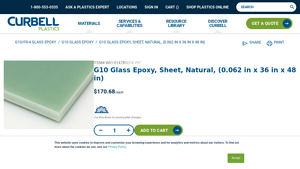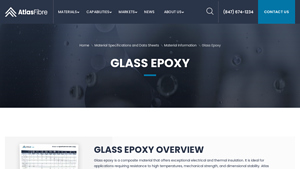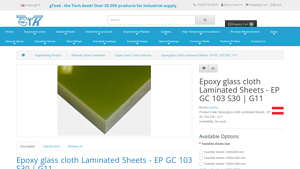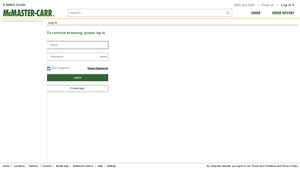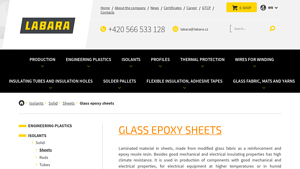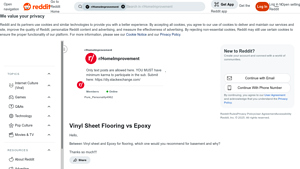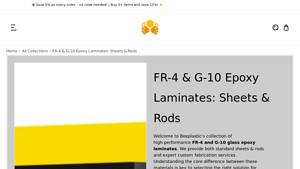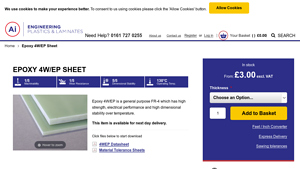Epoxy Sheet Guide: Type, Cost, Top List…
Introduction: Navigating the Global Market for epoxy sheet
Navigating the complexities of sourcing epoxy sheets can pose significant challenges for international B2B buyers, especially those in rapidly developing markets such as Africa, South America, the Middle East, and Europe. With a diverse array of options available, from G10 and FR-4 to custom-cut variations, understanding which type best fits specific applications is crucial. This guide offers a comprehensive exploration of epoxy sheets, delving into their various types, applications across different industries, and the nuances of supplier vetting to ensure quality and reliability.
By addressing key considerations such as performance characteristics, cost factors, and global sourcing strategies, this guide empowers B2B buyers to make informed purchasing decisions. Whether you are seeking high-strength materials for electrical insulation in Nigeria or durable solutions for aerospace applications in Germany, our resource equips you with the insights needed to navigate the global market effectively. We aim to demystify the selection process, helping you understand how to choose the right epoxy sheet for your unique project requirements while maximizing value and minimizing risk.
Join us as we unlock the potential of epoxy sheets, ensuring your business remains competitive in a challenging landscape.
Understanding epoxy sheet Types and Variations
| Type Name | Key Distinguishing Features | Primary B2B Applications | Brief Pros & Cons for Buyers |
|---|---|---|---|
| G10 | High strength, excellent electrical insulation, low moisture absorption | Electrical insulation, aerospace tooling, industrial machinery | Pros: High durability, good machinability. Cons: Can be more expensive than other options. |
| FR-4 | Flame-retardant properties, good mechanical strength, versatile | Circuit boards, insulators, industrial components | Pros: Cost-effective, reliable performance. Cons: Limited heat resistance compared to FR-5. |
| G11 | Higher temperature resistance than G10, good electrical properties | Aerospace, electrical equipment, high-temperature applications | Pros: Suitable for extreme conditions. Cons: Generally higher cost and weight. |
| FR-5 | Maintains properties at higher temperatures, flame-retardant | High-temperature electrical insulation, aerospace components | Pros: Excellent thermal stability. Cons: Higher production costs and complexity. |
| G14 | Enhanced thermal properties, suitable for demanding applications | Aerospace, automotive, high-performance parts | Pros: Superior heat resistance, strong mechanical performance. Cons: Limited availability and higher cost. |
What are the characteristics and suitability of G10 epoxy sheets for B2B buyers?
G10 epoxy sheets are highly regarded for their strength and machinability, making them ideal for precision engineering applications. Composed of fiberglass and epoxy resin, these sheets offer excellent electrical insulation, low moisture absorption, and high chemical resistance. For B2B buyers, G10 is suitable for a variety of applications, including aerospace tooling and industrial machinery. When purchasing, consider the specific thickness and size requirements for your project, as well as potential machining needs, which can affect overall costs.
How does FR-4 differ from other epoxy sheet types in terms of applications?
FR-4 sheets are a versatile choice due to their flame-retardant properties and reliable electrical insulation capabilities. Commonly used in circuit boards and insulators, FR-4 is a cost-effective solution for many mechanical and electrical applications. Buyers should note that while FR-4 provides excellent mechanical strength, it may not perform as well under high-temperature conditions compared to FR-5. When sourcing FR-4, ensure that the specifications meet the demands of your intended application, especially in environments with varying humidity.
What advantages do G11 epoxy sheets offer for high-temperature applications?
G11 epoxy sheets are designed for applications requiring higher temperature resistance than G10 sheets. They maintain good electrical properties and mechanical strength even under extreme conditions, making them suitable for aerospace and electrical equipment. For B2B buyers, G11 sheets can be a strategic investment for projects that may face elevated temperatures. However, the cost and weight may be considerations when evaluating G11 against other options. Ensure that suppliers can provide the necessary certification for high-temperature applications.
Why should B2B buyers consider FR-5 epoxy sheets for specialized applications?
FR-5 epoxy sheets are engineered to withstand high temperatures while retaining their mechanical and electrical properties. They are particularly beneficial in aerospace components and high-temperature electrical insulation applications. B2B buyers should consider FR-5 for its excellent thermal stability, which can enhance the lifespan and reliability of products. However, the increased complexity and cost of production may be a trade-off. When purchasing, verify that the FR-5 sheets meet the specific performance requirements of your application to ensure compliance and safety.
What makes G14 epoxy sheets suitable for demanding industrial environments?
G14 epoxy sheets excel in high-performance applications due to their enhanced thermal properties and superior mechanical strength. They are well-suited for industries such as aerospace and automotive, where reliability under demanding conditions is critical. For B2B buyers, G14 sheets represent a robust solution for applications that require both heat resistance and structural integrity. However, their limited availability and higher cost might necessitate careful planning and budget considerations. Assess your project’s specific needs to determine if G14 is the right fit for your operational requirements.
Key Industrial Applications of epoxy sheet
| Industry/Sector | Specific Application of epoxy sheet | Value/Benefit for the Business | Key Sourcing Considerations for this Application |
|---|---|---|---|
| Electrical & Electronics | Insulators and circuit boards | Enhanced safety and reliability in electrical systems | Ensure compliance with international electrical standards and certifications. |
| Aerospace & Defense | Tooling and structural components | Lightweight and high-strength solutions for critical applications | Prioritize materials with high-temperature resistance and low moisture absorption. |
| Automotive | Electrical insulation and mechanical parts | Improved durability and performance in vehicles | Look for customizable sizes and precise machining capabilities. |
| Industrial Machinery | Components for machinery and equipment | Increased efficiency and reduced maintenance costs | Consider sourcing from suppliers with proven quality control and rapid delivery capabilities. |
| Marine | Structural components and electrical insulation | Resistance to harsh environmental conditions | Evaluate chemical resistance and moisture absorption properties for longevity. |
How is Epoxy Sheet Used in Electrical and Electronics Applications?
In the electrical and electronics sector, epoxy sheets are primarily utilized for manufacturing insulators and circuit boards. Their exceptional electrical insulation properties ensure safety and reliability, preventing short circuits and electrical failures. For international buyers, particularly in regions like Africa and Europe, it is crucial to source epoxy sheets that meet stringent electrical standards and certifications, which can vary significantly across markets.
What Role Does Epoxy Sheet Play in Aerospace and Defense?
Epoxy sheets are vital in aerospace and defense for creating tooling and structural components that require a combination of lightweight design and high strength. These materials can withstand extreme temperatures and environmental conditions, making them ideal for aircraft and military applications. Buyers in this sector should focus on suppliers that offer materials with documented performance in high-stress environments, ensuring compliance with industry standards.
How is Epoxy Sheet Beneficial in the Automotive Industry?
In the automotive industry, epoxy sheets serve as electrical insulation and form mechanical parts that enhance vehicle performance. Their durability contributes to the longevity of components, reducing maintenance and replacement costs. Buyers should consider sourcing epoxy sheets that can be custom cut to fit specific automotive applications, ensuring compatibility with existing designs and adherence to automotive safety standards.
Why is Epoxy Sheet Essential for Industrial Machinery?
Epoxy sheets find extensive use in industrial machinery, where they are crafted into various components that demand high mechanical strength and durability. By improving operational efficiency, these materials help reduce downtime and maintenance expenses. International B2B buyers should prioritize suppliers who can provide consistent quality and rapid delivery to meet the dynamic needs of industrial operations.
How Does Epoxy Sheet Enhance Marine Applications?
In the marine industry, epoxy sheets are critical for constructing structural components and providing electrical insulation. Their resistance to moisture and chemicals ensures longevity and reliability in harsh marine environments. Buyers should look for epoxy sheets with excellent moisture absorption resistance and robust chemical properties to guarantee performance in challenging conditions, particularly for applications in regions with demanding climates.
3 Common User Pain Points for ‘epoxy sheet’ & Their Solutions
Scenario 1: Difficulties with Sourcing High-Quality Epoxy Sheets
The Problem: B2B buyers often struggle to find reliable suppliers that offer high-quality epoxy sheets. In regions like Africa and South America, where local suppliers may lack the necessary certifications or product consistency, this can lead to procurement challenges. Buyers might encounter issues with material performance, such as inadequate electrical insulation or poor chemical resistance, which can jeopardize their projects. The uncertainty surrounding the quality can also result in wasted resources, time, and increased costs.
The Solution: To ensure the procurement of high-quality epoxy sheets, buyers should prioritize suppliers with a proven track record in the industry. It is advisable to request product samples and certifications, such as ISO or ASTM standards, before placing bulk orders. Additionally, engaging with suppliers who offer detailed technical data sheets can provide insights into the material’s properties and applications. Buyers can also benefit from leveraging platforms that specialize in B2B transactions, where they can read reviews and feedback from other customers regarding product quality. Establishing long-term relationships with trusted suppliers can lead to improved pricing and reliability over time.
Scenario 2: Inadequate Knowledge of Product Specifications
The Problem: Another common pain point for B2B buyers is the lack of understanding regarding the specifications and applications of different types of epoxy sheets, such as G10 and FR-4. This knowledge gap can result in selecting inappropriate materials for specific applications, leading to product failure or costly redesigns. For example, using a standard epoxy sheet in a high-temperature environment can compromise the integrity of the components, impacting overall performance.
The Solution: To overcome this challenge, buyers should invest time in researching the various types of epoxy sheets and their specific properties. Engaging with manufacturers or technical experts who can provide personalized consultations is beneficial. Buyers should seek out suppliers that offer comprehensive guides or webinars on epoxy materials, detailing their mechanical, thermal, and chemical resistance properties. Creating a checklist of project requirements—such as temperature ranges, load-bearing capacities, and environmental conditions—can assist in accurately matching the right type of epoxy sheet to the intended application. Additionally, utilizing sample kits for testing in real-world conditions can ensure that the chosen material meets performance expectations.
Scenario 3: Challenges in Custom Fabrication and Machining
The Problem: Many B2B buyers face difficulties when it comes to custom fabrication and machining of epoxy sheets. This can stem from a lack of in-house capabilities, insufficient knowledge about the best machining practices, or challenges with sourcing the right tools. Inadequate machining can lead to rough edges, inconsistent dimensions, and ultimately, subpar finished products. This issue is particularly prevalent in industries that demand precision, such as aerospace and electronics.
The Solution: To address the challenges of custom fabrication, buyers should consider partnering with suppliers that offer machining services or can recommend reliable fabrication partners. When sourcing epoxy sheets, it is crucial to inquire about the recommended machining guidelines, such as cutting speeds, tool types, and post-processing techniques. Buyers should also educate themselves about common machining methods for epoxy materials, like CNC machining and laser cutting, to ensure they are utilizing the best practices. For those with in-house capabilities, investing in the right tools and training staff on proper machining techniques can enhance efficiency and product quality. Establishing a quality control protocol during the fabrication process can also help identify issues early and ensure that the final products meet the required specifications.
Strategic Material Selection Guide for epoxy sheet
What Are the Key Properties of G10 Epoxy Sheets?
G10 epoxy sheets, also known as FR-4, are composite materials made from woven fiberglass cloth saturated with epoxy resin. They exhibit exceptional mechanical strength, heat resistance, and electrical insulation properties, making them suitable for various industrial applications. G10 sheets can withstand temperatures up to 130°C (266°F) and offer excellent corrosion resistance against chemicals, solvents, and moisture. Their low moisture absorption rate ensures durability in humid environments, which is crucial for applications in regions like Africa and South America.
What Are the Pros and Cons of Using G10 Epoxy Sheets?
Pros: G10 sheets are highly durable and versatile, making them ideal for applications such as electrical insulation, aerospace tooling, and industrial machinery. Their machinability allows for precise fabrication into custom components, enhancing their suitability for specialized projects.
Cons: The primary drawback of G10 sheets is their relatively high cost compared to other materials like PVC or standard fiberglass. Additionally, the manufacturing process can be complex, requiring specialized equipment for cutting and shaping, which may not be readily available in all regions.
How Do G10 Epoxy Sheets Impact Specific Applications?
The unique properties of G10 sheets make them particularly effective in electrical insulation applications. They are commonly used in circuit boards, insulators, and mechanical components that require high strength and thermal stability. For international buyers, understanding the specific media compatibility—such as resistance to oils or solvents—is essential to ensure optimal performance in their applications.
What Should International B2B Buyers Consider When Selecting G10 Epoxy Sheets?
International buyers, especially from regions like Europe and the Middle East, should be aware of compliance with local standards such as ASTM, DIN, and JIS. These standards dictate the quality and performance metrics for materials used in critical applications. Additionally, buyers should consider the availability of suppliers who can provide certified materials that meet these standards, ensuring that their projects adhere to regulatory requirements.
What Are the Key Properties of G11 Epoxy Sheets?
G11 epoxy sheets are similar to G10 but are designed for higher operating temperatures, capable of withstanding up to 180°C (356°F). They provide excellent electrical insulation and mechanical strength, making them suitable for applications in the aerospace and automotive industries. G11 sheets also offer enhanced chemical resistance, making them ideal for environments exposed to aggressive media.
What Are the Pros and Cons of Using G11 Epoxy Sheets?
Pros: The high-temperature tolerance of G11 sheets makes them an excellent choice for applications requiring durability under extreme conditions. They also maintain their mechanical properties in humid environments, which is beneficial for industries operating in tropical climates.
Cons: G11 sheets can be more expensive than G10 due to their specialized manufacturing process. Additionally, their increased rigidity may limit their machinability compared to G10 sheets, requiring more advanced machining techniques.
How Do G11 Epoxy Sheets Impact Specific Applications?
G11 sheets are commonly used in high-performance electrical insulation applications, such as transformer components and high-voltage equipment. Their superior thermal stability ensures reliable performance in environments where temperature fluctuations are common.
What Should International B2B Buyers Consider When Selecting G11 Epoxy Sheets?
Buyers should verify that G11 sheets comply with international standards relevant to their industry. Additionally, they should assess the supplier’s ability to provide documentation demonstrating compliance with these standards, particularly in regions with stringent regulations like Germany.
What Are the Key Properties of FR-4 Epoxy Sheets?
FR-4 epoxy sheets are widely recognized for their flame-retardant properties and are often used in applications requiring safety certifications. They can withstand temperatures up to 130°C (266°F) and provide excellent electrical insulation and mechanical strength. The material is also resistant to moisture and chemicals, making it suitable for various industrial applications.
What Are the Pros and Cons of Using FR-4 Epoxy Sheets?
Pros: FR-4 sheets are cost-effective and readily available, making them a popular choice for many applications. Their flame-retardant properties add an extra layer of safety, which is crucial in electrical and electronic applications.
Cons: While FR-4 sheets are versatile, they may not offer the same high-temperature resistance as G10 or G11 sheets. This limitation can restrict their use in high-performance applications where extreme conditions are present.
How Do FR-4 Epoxy Sheets Impact Specific Applications?
FR-4 sheets are commonly used in the manufacturing of circuit boards, insulators, and various electrical components. Their flame-retardant properties make them particularly suitable for applications in the electronics industry, where safety is paramount.
What Should International B2B Buyers Consider When Selecting FR-4 Epoxy Sheets?
Buyers should ensure that FR-4 sheets meet relevant safety standards and certifications, particularly in sectors like electronics where compliance is critical. Understanding the specific requirements of their application, including temperature and chemical exposure, will help buyers select the most appropriate material.
| Material | Typical Use Case for epoxy sheet | Key Advantage | Key Disadvantage/Limitation | Relative Cost (Low/Med/High) |
|---|---|---|---|---|
| G10 | Electrical insulation, aerospace tooling | High strength and machinability | Higher cost and complex manufacturing | Medium |
| G11 | High-performance electrical insulation | Superior thermal stability | More expensive, limited machinability | High |
| FR-4 | Circuit boards, electrical components | Flame-retardant, cost-effective | Limited high-temperature resistance | Low |
In-depth Look: Manufacturing Processes and Quality Assurance for epoxy sheet
What Are the Key Stages in the Manufacturing Process of Epoxy Sheets?
The manufacturing process of epoxy sheets, particularly G10 and FR-4 types, involves several critical stages that ensure the production of high-quality materials suitable for various industrial applications. Understanding these stages can help B2B buyers make informed decisions when sourcing epoxy sheets.
Material Preparation
The first step in the manufacturing of epoxy sheets is material preparation. This involves selecting high-quality fiberglass cloth and epoxy resin, which are the primary components of the sheets. The fiberglass is typically woven into a specific pattern to enhance strength and durability. The resin is chosen based on its thermal and mechanical properties, ensuring it meets the required specifications for the intended application.
Once the materials are selected, the fiberglass layers are soaked in the epoxy resin. This step is crucial as it ensures that the resin fully saturates the fiberglass, allowing for optimal bonding and performance.
Forming the Sheets
After the materials are prepared, the next stage is forming the sheets. This process generally involves layering the soaked fiberglass cloth in a specific orientation, depending on the desired strength characteristics of the final product. The layers are then placed in a mold and subjected to heat and pressure in a process known as lamination.
The heat causes the epoxy resin to cure, hardening the material and providing structural integrity. The pressure ensures that the layers adhere firmly to one another, eliminating any air pockets that could compromise the material’s performance.
Assembly and Finishing
Once the sheets have cured, they undergo assembly and finishing processes. This stage may include cutting the sheets to specific dimensions, drilling holes, or applying surface finishes. CNC machining is often employed to achieve precise cuts and shapes, allowing for customizations based on client specifications.
Quality checks are integrated into this stage to ensure that the dimensions and finishes meet the required standards. This may involve measuring thickness, inspecting surface quality, and verifying that the sheets are free from defects.
How Is Quality Assurance Implemented in Epoxy Sheet Manufacturing?
Quality assurance (QA) is a fundamental aspect of the manufacturing process for epoxy sheets. It ensures that the final products meet international standards and customer expectations.
What International Standards Apply to Epoxy Sheets?
Several international standards govern the quality and safety of epoxy sheets. Notably, ISO 9001 is a widely recognized standard that outlines requirements for a quality management system. Compliance with ISO 9001 helps manufacturers establish a framework for consistent quality in production processes.
Additionally, certifications such as CE (Conformité Européenne) and API (American Petroleum Institute) may apply depending on the application. For instance, CE marking indicates that the product meets European safety and environmental requirements, while API standards may be relevant for products used in the oil and gas industry.
What Are the Key Quality Control Checkpoints in the Manufacturing Process?
Quality control (QC) involves several checkpoints throughout the manufacturing process:
-
Incoming Quality Control (IQC): This initial checkpoint assesses the quality of raw materials, such as fiberglass and resin, before they enter the production line. Suppliers must provide certificates of analysis (CoA) for the materials to ensure they meet specified standards.
-
In-Process Quality Control (IPQC): During production, various tests are conducted to monitor the quality of the sheets as they are formed. This may include checking the curing process, measuring temperature and pressure during lamination, and ensuring proper layer alignment.
-
Final Quality Control (FQC): Once the sheets are completed, they undergo final inspection. This includes dimensional checks, surface quality assessments, and mechanical property tests such as tensile strength and electrical insulation resistance.
What Testing Methods Are Commonly Used for Epoxy Sheets?
B2B buyers should be familiar with the testing methods employed to ensure the quality of epoxy sheets. Common testing methods include:
-
Mechanical Testing: This involves assessing the tensile strength, compression strength, and impact resistance of the sheets. Testing ensures that the materials can withstand the mechanical stresses they will encounter in their applications.
-
Electrical Testing: Since many epoxy sheets are used for electrical insulation, tests are conducted to measure dielectric strength and insulation resistance. This ensures that the sheets will perform effectively in high-voltage applications.
-
Thermal Testing: Epoxy sheets are often subjected to heat resistance tests to evaluate their performance at elevated temperatures. This is crucial for applications in environments where heat exposure is a concern.
How Can B2B Buyers Verify Supplier Quality Control Processes?
For international B2B buyers, particularly those in regions like Africa, South America, the Middle East, and Europe, verifying a supplier’s quality control processes is essential to ensure product reliability.
What Steps Can Buyers Take to Assess Supplier QC?
-
Conduct Audits: Buyers should consider performing on-site audits of potential suppliers. This allows them to observe manufacturing practices, quality control procedures, and compliance with international standards.
-
Request Documentation: Suppliers should provide documentation regarding their quality management systems, including certifications and quality control reports. This documentation should detail their adherence to standards like ISO 9001.
-
Third-Party Inspections: Engaging third-party inspection agencies can provide an unbiased assessment of the supplier’s quality processes. These agencies can perform tests and inspections to verify product quality before shipment.
-
Review Customer Feedback: Buyers can look for reviews or testimonials from other companies that have sourced products from the supplier. This feedback can offer insights into the supplier’s reliability and product quality.
What Nuances Should International Buyers Consider Regarding QC and Certification?
International buyers should be aware of specific nuances related to QC and certification:
-
Regulatory Compliance: Different regions may have varying regulatory requirements. Buyers should ensure that the supplier’s products comply with local regulations in their respective markets.
-
Traceability: Understanding the traceability of materials used in production is vital. Buyers should inquire about the origin of raw materials and the supplier’s practices for maintaining traceability throughout the manufacturing process.
-
Cultural and Communication Differences: Language barriers and cultural differences can impact the clarity of communication regarding quality expectations. Establishing clear lines of communication and expectations can mitigate misunderstandings.
In conclusion, understanding the manufacturing processes and quality assurance practices for epoxy sheets is crucial for B2B buyers. By familiarizing themselves with these processes, buyers can make informed decisions and select reliable suppliers that meet their quality standards.
Practical Sourcing Guide: A Step-by-Step Checklist for ‘epoxy sheet’
In the competitive landscape of B2B sourcing, finding the right epoxy sheet is crucial for ensuring product quality and operational efficiency. This guide serves as a comprehensive checklist to help international buyers navigate the procurement process effectively, particularly for those in regions like Africa, South America, the Middle East, and Europe.
Step 1: Define Your Technical Specifications
Before initiating the sourcing process, clearly outline the technical requirements for the epoxy sheet. This includes defining the desired dimensions, thickness, and material properties such as mechanical strength, heat resistance, and chemical resistance. Knowing these specifications upfront will help narrow down potential suppliers and ensure you select a product that meets your application needs.
Step 2: Research Available Epoxy Sheet Types
Familiarize yourself with the various types of epoxy sheets available, such as G10, G11, and FR-4. Each type has distinct characteristics suited for specific applications—G10, for instance, is known for its excellent electrical insulation properties and high mechanical strength. Understanding these differences will empower you to make informed decisions based on your project’s requirements.
Step 3: Evaluate Potential Suppliers
Conduct thorough evaluations of potential suppliers to ensure reliability and quality. Look for established manufacturers with a proven track record in the industry. Request documentation such as company profiles, quality certifications, and customer testimonials. This step is vital to mitigate risks associated with product quality and supplier reliability.
Step 4: Request Samples for Testing
Once you have identified potential suppliers, request samples of the epoxy sheets you are considering. Testing samples allows you to assess the material’s performance in your specific application. Pay attention to attributes such as machinability, durability, and resistance to environmental factors. This hands-on evaluation can prevent costly mistakes later in the procurement process.
Step 5: Verify Compliance with Industry Standards
Ensure that the epoxy sheets comply with relevant industry standards and regulations, especially if you are operating in sectors like aerospace or electrical engineering. Look for certifications that demonstrate adherence to safety, environmental, and quality management standards. Compliance not only ensures product reliability but also enhances your business’s credibility in the marketplace.
Step 6: Discuss Pricing and Payment Terms
Engage suppliers in discussions about pricing structures and payment terms. Seek clarity on bulk order discounts, shipping costs, and lead times for delivery. Understanding these financial aspects upfront can aid in budgeting and help you avoid unexpected costs down the line.
Step 7: Establish a Clear Communication Channel
Set up a clear communication channel with your chosen supplier. Discuss expectations regarding order updates, shipping notifications, and any potential issues that may arise during the procurement process. Effective communication fosters a strong partnership and ensures that both parties are aligned on project timelines and deliverables.
By following this checklist, B2B buyers can streamline their sourcing process for epoxy sheets, ensuring that they procure high-quality materials that meet their operational needs while minimizing risks associated with supplier selection.
Comprehensive Cost and Pricing Analysis for epoxy sheet Sourcing
What Are the Key Cost Components for Sourcing Epoxy Sheets?
When sourcing epoxy sheets, understanding the cost structure is crucial for B2B buyers. The primary cost components include:
-
Materials: The base materials for epoxy sheets—primarily fiberglass and epoxy resin—constitute a significant portion of the total cost. The quality of these materials can affect both performance and price, with high-grade fiberglass and premium epoxy resins commanding higher prices.
-
Labor: Labor costs encompass the wages of workers involved in the manufacturing process. This includes skilled labor for machining and finishing operations, which may vary based on the region, labor laws, and the skill level required.
-
Manufacturing Overhead: This includes indirect costs related to production, such as utilities, rent, and equipment maintenance. Efficient production processes can help keep these costs low, which is beneficial for both manufacturers and buyers.
-
Tooling: Custom tooling costs can arise if specific designs or cuts are required. While initial tooling can be expensive, it is often amortized over large production runs, making it more cost-effective in the long run.
-
Quality Control (QC): Implementing strict QC processes ensures that the epoxy sheets meet required specifications and standards. This is particularly important for applications where reliability is critical, such as in the aerospace or electrical industries.
-
Logistics: Shipping costs can vary greatly depending on the distance, mode of transport, and the Incoterms agreed upon. It’s essential to factor in these costs when calculating the total price of epoxy sheets.
-
Margin: Suppliers will typically add a margin to cover their operational costs and profit. This margin can vary based on supplier reputation, market demand, and competition.
How Do Price Influencers Impact the Cost of Epoxy Sheets?
Several factors can influence the pricing of epoxy sheets:
-
Volume/MOQ: Purchasing in larger quantities often leads to significant discounts. Manufacturers may have minimum order quantities (MOQs) that can affect pricing dynamics.
-
Specifications and Customization: Custom specifications, such as thickness, dimensions, or specific chemical properties, can increase costs due to the additional manufacturing processes involved.
-
Material Quality and Certifications: Higher quality materials often come with certifications that ensure compliance with industry standards, which can influence pricing. Buyers should evaluate whether these certifications are necessary for their applications.
-
Supplier Factors: The reputation and reliability of suppliers can impact pricing. Established suppliers may charge a premium for their products due to perceived quality and service levels.
-
Incoterms: The choice of Incoterms affects not only the logistics costs but also the risk associated with shipping. Terms such as CIF (Cost, Insurance, and Freight) can lead to higher upfront costs but may offer better protection against shipping risks.
What Are Effective Buyer Tips for Sourcing Epoxy Sheets?
When sourcing epoxy sheets, international buyers, particularly from regions like Africa, South America, the Middle East, and Europe, should consider the following tips:
-
Negotiate Wisely: Leverage your purchasing power when negotiating prices. Suppliers are often willing to provide discounts for bulk orders or long-term contracts.
-
Consider Total Cost of Ownership (TCO): Beyond the initial purchase price, consider ongoing costs such as maintenance, durability, and potential downtime. A higher upfront cost may be justified if the material lasts longer or requires less maintenance.
-
Understand Pricing Nuances for International Markets: Currency fluctuations, import tariffs, and shipping costs can significantly affect the final price of epoxy sheets. Ensure to conduct thorough research and possibly consult with local experts to mitigate these risks.
-
Quality Over Cost: While it may be tempting to go for the cheapest option, prioritize quality to avoid potential failures in critical applications. The cost of failure can far exceed initial savings.
-
Stay Informed on Market Trends: Keep abreast of changes in material costs, supply chain disruptions, and technological advancements in the epoxy sheet industry. This knowledge can provide leverage in negotiations and sourcing decisions.
Disclaimer
The prices referenced in this analysis are indicative and may vary based on market conditions, supplier negotiations, and specific project requirements. Buyers are encouraged to conduct due diligence and obtain quotes from multiple suppliers to ensure competitive pricing.
Alternatives Analysis: Comparing epoxy sheet With Other Solutions
When considering material solutions for applications such as electrical insulation and mechanical components, it’s essential to evaluate various options available in the market. This section explores how epoxy sheets, particularly G10 and FR-4 variants, compare with other viable alternatives like Polycarbonate Sheets and PVC Sheets. By understanding their performance, cost, ease of implementation, maintenance, and best use cases, B2B buyers can make informed decisions tailored to their specific needs.
Comparison Table
| Comparison Aspect | Epoxy Sheet | Polycarbonate Sheets | PVC Sheets |
|---|---|---|---|
| Performance | High mechanical strength, excellent electrical insulation, and chemical resistance. | Good impact resistance, moderate thermal insulation, and UV stability. | Moderate mechanical strength, good chemical resistance, but poor electrical insulation. |
| Cost | Higher initial cost ($170 for a standard sheet). | Moderate cost, typically lower than epoxy sheets. | Generally the most cost-effective option. |
| Ease of Implementation | Requires precise machining and cutting; can be custom fabricated. | Easy to cut and shape; available in various sizes. | Very easy to work with; can be cut with standard tools. |
| Maintenance | Low maintenance; durable under various conditions. | Low maintenance; good longevity but can scratch easily. | Low maintenance; however, can become brittle over time. |
| Best Use Case | Ideal for electrical insulation, aerospace, and precision components. | Best for applications requiring transparency and high impact resistance, such as safety shields. | Suitable for general-purpose applications and low-stress environments. |
In-Depth Analysis of Alternatives
Polycarbonate Sheets
Polycarbonate sheets are a robust alternative to epoxy sheets, particularly valued for their high impact resistance and clarity. They are lightweight and can be easily fabricated, making them suitable for applications such as safety shields and protective covers. While they provide moderate thermal insulation, they can degrade under prolonged UV exposure unless treated. Polycarbonate’s cost is generally lower than epoxy sheets, making it a budget-friendly option for projects where electrical insulation is not a primary concern. However, their mechanical strength does not match the durability of epoxy sheets, which may limit their use in high-stress applications.
PVC Sheets
PVC sheets are another cost-effective alternative, known for their versatility and ease of installation. They are lightweight, resistant to many chemicals, and can be easily cut and fabricated using standard tools. PVC is suitable for general-purpose applications, such as signage and low-stress structural components. However, PVC sheets lack the electrical insulation properties of epoxy sheets, making them unsuitable for high-voltage applications. Their mechanical strength is also lower, and they can become brittle over time, particularly under UV exposure. Therefore, while PVC sheets may be more economical, they may not provide the durability and performance required for demanding applications.
Conclusion: How to Choose the Right Solution for Your Needs
When selecting between epoxy sheets and their alternatives, B2B buyers must consider several factors, including the specific application requirements, budget constraints, and long-term performance expectations. Epoxy sheets excel in environments demanding high mechanical strength and electrical insulation, making them ideal for specialized applications in aerospace, electronics, and precision engineering. Conversely, alternatives like polycarbonate and PVC sheets may be more suitable for general-purpose applications where cost is a priority, and high-performance specifications are not critical. Understanding these nuances will enable buyers to make informed decisions that align with their operational needs and project goals.
Essential Technical Properties and Trade Terminology for epoxy sheet
What Are the Key Technical Properties of Epoxy Sheets?
Epoxy sheets, particularly G10 and FR-4 types, are known for their exceptional performance in various industrial applications. Understanding their critical specifications can help B2B buyers make informed decisions.
1. Material Grade
Material grade refers to the specific classification of epoxy sheets based on their composition and intended use. Common grades include G10, FR-4, and G11, each with unique properties. G10 is favored for its high mechanical strength and electrical insulation, making it ideal for electrical components. Understanding material grades is essential for ensuring that the chosen epoxy sheet meets the required performance criteria for specific applications.
2. Thickness and Tolerance
Thickness is a crucial specification that determines the sheet’s strength and applicability in different environments. Standard thicknesses range from 0.062 inches to larger dimensions, depending on the application. Tolerance indicates the allowable variation in thickness and dimensions during manufacturing. Accurate thickness and tolerance are vital for machining processes and ensuring proper fit in assemblies, impacting overall product reliability and performance.
3. Thermal and Electrical Insulation Properties
Epoxy sheets offer excellent thermal and electrical insulation properties, crucial for applications in the electrical and electronics industries. High dielectric strength enables them to withstand high voltages, making them suitable for circuit boards and insulators. Buyers should assess these properties based on operational temperature ranges and electrical requirements to ensure compliance with industry standards.
4. Chemical Resistance
Chemical resistance describes the material’s ability to withstand various corrosive substances without degrading. This property is essential for applications in chemical processing or environments where exposure to solvents, acids, and bases is common. Understanding chemical resistance helps buyers select the right epoxy sheets for their specific operational environments, preventing premature failure and ensuring longevity.
5. Moisture Absorption
Moisture absorption is a critical property that reflects how well the material resists absorbing water. Low moisture absorption rates are essential for maintaining dimensional stability and preventing warping or degradation in humid conditions. This property is particularly important for applications in environments prone to moisture, such as marine or outdoor settings.
What Are Common Trade Terms Related to Epoxy Sheets?
Familiarity with industry jargon is vital for effective communication between buyers and suppliers in the epoxy sheet market. Here are some common terms:
1. OEM (Original Equipment Manufacturer)
OEM refers to a company that produces parts or equipment that may be marketed by another manufacturer. In the context of epoxy sheets, buyers often seek OEM products for specific applications, ensuring compatibility and quality assurance.
2. MOQ (Minimum Order Quantity)
MOQ is the smallest number of units a supplier is willing to sell. Understanding MOQ is crucial for B2B buyers, as it affects inventory management and cost efficiency. Buyers must assess whether the MOQ aligns with their project needs and budget.
3. RFQ (Request for Quotation)
An RFQ is a formal document sent to suppliers to request pricing and terms for specific products. When sourcing epoxy sheets, submitting an RFQ allows buyers to compare offers, ensuring they get the best value for their investment.
4. Incoterms (International Commercial Terms)
Incoterms are a set of internationally recognized rules that define the responsibilities of buyers and sellers in international transactions. Understanding these terms helps buyers navigate shipping costs, insurance, and delivery responsibilities, reducing potential disputes.
5. Lead Time
Lead time refers to the amount of time it takes from placing an order to receiving the product. Knowing the lead time for epoxy sheets is essential for project planning and scheduling, especially in industries where timely delivery is critical.
By grasping these essential technical properties and trade terms, B2B buyers can make better-informed decisions when sourcing epoxy sheets, ensuring they meet their specific project requirements while optimizing costs and efficiency.
Navigating Market Dynamics and Sourcing Trends in the epoxy sheet Sector
What Are the Key Trends Shaping the Global Epoxy Sheet Market?
The global epoxy sheet market is experiencing significant transformation driven by technological advancements and evolving buyer preferences. Key drivers include the increasing demand for high-performance materials across industries such as aerospace, automotive, electronics, and industrial machinery. This demand is fueled by the need for materials that offer superior mechanical strength, thermal stability, and excellent electrical insulation properties.
Emerging trends in sourcing practices reflect a shift towards digital transformation. B2B buyers are leveraging online platforms for procurement, enabling easier access to suppliers, competitive pricing, and streamlined processes. Moreover, the rise of custom solutions is notable, with suppliers offering tailored sizes and specifications to meet unique project requirements. As markets in Africa, South America, the Middle East, and Europe mature, buyers are increasingly looking for suppliers who can provide rapid delivery and inventory management solutions, ensuring that production timelines are met without compromise.
Another significant trend is the growing focus on quality certifications and compliance with international standards. Buyers are now more vigilant about sourcing materials that meet specific performance benchmarks, such as ASTM and ISO certifications, which can enhance product credibility and ensure safety in end-use applications.
How Is Sustainability Influencing Sourcing Decisions in the Epoxy Sheet Sector?
Sustainability is becoming a pivotal concern for B2B buyers in the epoxy sheet market. The environmental impact of manufacturing processes and the lifecycle of materials is under scrutiny, pushing companies to prioritize sustainable sourcing practices. Buyers are increasingly seeking suppliers who adopt eco-friendly production methods and utilize raw materials that minimize environmental harm.
The importance of ethical supply chains cannot be overstated. Companies are now assessing their suppliers’ sustainability practices, including waste management, energy consumption, and responsible sourcing of raw materials. This trend is particularly pronounced in regions like Europe, where stringent regulations promote sustainability.
Furthermore, the availability of ‘green’ certifications is gaining traction. Buyers are encouraged to look for materials that are certified by recognized organizations for their environmental compliance. These certifications not only demonstrate a commitment to sustainability but also enhance brand reputation and customer trust. As a result, sourcing epoxy sheets from manufacturers who prioritize sustainability can provide a competitive edge in the market.
What Is the Historical Context of the Epoxy Sheet Industry?
The epoxy sheet industry has evolved significantly since the introduction of epoxy resins in the mid-20th century. Initially utilized for their adhesive properties, epoxy resins began to gain traction as a material for industrial applications due to their excellent mechanical and electrical insulation characteristics. The development of fiberglass-reinforced epoxy sheets, particularly G10 and FR-4, marked a pivotal moment, broadening their application across various sectors.
As industries evolved, so did the formulations and manufacturing processes of epoxy sheets, leading to enhanced performance characteristics such as improved heat resistance, moisture absorption, and chemical stability. This evolution has been driven by the increasing complexity of applications in high-tech industries, where performance and reliability are paramount.
Today, epoxy sheets are recognized for their versatility and have become integral in sectors ranging from electrical insulation to aerospace tooling. As manufacturers continue to innovate, the future of the epoxy sheet market looks promising, with opportunities for growth in emerging markets and applications.
Frequently Asked Questions (FAQs) for B2B Buyers of epoxy sheet
-
How do I choose the right epoxy sheet for my application?
Selecting the appropriate epoxy sheet involves assessing the specific requirements of your project, including mechanical strength, electrical insulation properties, and resistance to chemicals and moisture. G10 and FR-4 are popular choices due to their versatility and performance characteristics. Consider the sheet’s thickness, size, and form (sheet, rod, or custom cut) based on your design needs. Consulting with suppliers about your application can also provide insights into the best options available. -
What are the key properties of G10 epoxy sheets?
G10 epoxy sheets are renowned for their exceptional mechanical strength, electrical insulation, and resistance to moisture and chemicals. With a tensile strength of approximately 40,000 psi, they can withstand demanding conditions, making them suitable for applications in electrical insulation, aerospace tooling, and industrial machinery. They also exhibit low moisture absorption, ensuring durability in humid environments, which is crucial for industries operating in regions like Africa and South America. -
What customization options are available for epoxy sheets?
Most suppliers offer customization options for epoxy sheets, including various sizes, thicknesses, and cuts tailored to specific project needs. You can request CNC machining, die cutting, or laser cutting to achieve precise dimensions. Customization enhances the applicability of epoxy sheets in unique projects, ensuring that they meet the exact specifications required for various industrial applications. -
What are the minimum order quantities (MOQs) for epoxy sheets?
Minimum order quantities for epoxy sheets can vary significantly by supplier and product type. Some manufacturers may have MOQs as low as a single sheet, while others might require larger orders to ensure cost-effectiveness. It’s advisable to discuss your needs directly with suppliers to explore flexibility in MOQs, especially if you are sourcing materials for projects in different regions, such as Europe or the Middle East. -
What payment terms should I expect when sourcing epoxy sheets internationally?
Payment terms can differ based on the supplier’s policies and the buyer’s location. Common practices include upfront payments, letters of credit, or payment upon delivery. For international transactions, consider factors like currency exchange rates and transaction fees. Establishing clear payment terms before finalizing an order can help prevent misunderstandings and ensure a smooth procurement process. -
How do I ensure quality assurance when sourcing epoxy sheets?
To ensure quality, request detailed product specifications and certifications from suppliers. Many manufacturers provide technical data sheets that outline material properties and compliance with industry standards. It’s also beneficial to inquire about their quality control processes, including any third-party testing. If possible, request samples to evaluate the material before placing a larger order, particularly when dealing with international suppliers. -
What logistics considerations should I keep in mind when importing epoxy sheets?
Logistics is a crucial aspect of sourcing epoxy sheets internationally. Consider shipping methods, lead times, and customs regulations in your destination country. It’s important to partner with reliable logistics providers who understand the intricacies of importing materials. Additionally, ensure that your supplier can provide necessary documentation for customs clearance, such as invoices and certificates of origin, to avoid delays. -
How can I vet suppliers for epoxy sheets in international markets?
When vetting suppliers, research their reputation by checking customer reviews and industry ratings. Look for suppliers with experience in the specific type of epoxy sheet you need and verify their manufacturing capabilities. Engaging in direct communication can also provide insights into their customer service and responsiveness. Consider requesting references or samples and, if possible, visiting their facilities to assess their operations firsthand, especially when sourcing from regions like Africa or South America.
Important Disclaimer & Terms of Use
⚠️ Important Disclaimer
The information provided in this guide, including content regarding manufacturers, technical specifications, and market analysis, is for informational and educational purposes only. It does not constitute professional procurement advice, financial advice, or legal advice.
While we have made every effort to ensure the accuracy and timeliness of the information, we are not responsible for any errors, omissions, or outdated information. Market conditions, company details, and technical standards are subject to change.
B2B buyers must conduct their own independent and thorough due diligence before making any purchasing decisions. This includes contacting suppliers directly, verifying certifications, requesting samples, and seeking professional consultation. The risk of relying on any information in this guide is borne solely by the reader.
Top 10 Epoxy Sheet Manufacturers & Suppliers List
1. Eplastics – G10/FR4 Epoxy Sheet
Domain: eplastics.com
Registered: 1998 (27 years)
Introduction: G10/FR4 Epoxy Sheet is a high-performance dielectric laminate made from fiberglass cloth and epoxy resin that is known for its excellent mechanical properties. This material has a high strength-to-weight ratio and good electrical insulation properties. It is suitable for applications that require dimensional stability, chemical resistance, and electrical insulation. The sheets are available in var…
2. Curbell Plastics – G10 Glass Epoxy Sheet
Domain: curbellplastics.com
Registered: 2000 (25 years)
Introduction: {‘product_name’: ‘G10 Glass Epoxy, Sheet, Natural’, ‘item_number’: ‘W01-01478’, ‘dimensions’: {‘thickness’: ‘0.062 in’, ‘width’: ’36 in’, ‘length’: ’48 in’}, ‘price’: ‘$170.68 /each’, ‘performance_characteristics’: {‘heat_resistance’: ‘Withstands high temperatures without significant degradation’, ‘mechanical_strength’: ‘Reliable performance in mechanical applications requiring strength and rigidi…
3. Atlas Fibre – Glass Epoxy Solutions
Domain: atlasfibre.com
Registered: 1996 (29 years)
Introduction: Glass epoxy is a composite material known for exceptional electrical and thermal insulation, ideal for high temperature resistance, mechanical strength, and dimensional stability. Atlas Fibre offers several types of glass epoxy, including G-10, G-11, and FR-4. G-10 is a non-flame retardant, halogen-free variant with excellent electrical insulation and high mechanical strength, suitable for cryogen…
4. Gteek – Epoxy Glass Cloth Laminated Sheets
Domain: gteek.com
Registered: 2017 (8 years)
Introduction: Product Name: Epoxy Glass Cloth Laminated Sheets – EP GC 103 S30 | G11
5. McMaster – Glass/Epoxy Laminate Selection
Domain: mcmaster.com
Registered: 1994 (31 years)
Introduction: This company, McMaster – Glass/Epoxy Laminate Selection, is a notable entity in the market. For specific product details, it is recommended to visit their website directly.
6. Labara – Glass Epoxy Sheets
Domain: labara.cz
Registered: 2001 (24 years)
Introduction: Glass epoxy sheets are laminated materials made from modified glass fabric and epoxy resin, offering good mechanical and electrical insulating properties along with high climate resistance. They are used in the production of components for electrical equipment in high temperatures or humid environments, such as chassis, body equipment, housing parts of distribution boards, transformers, switchgear…
7. Z Telec Group – FR4 Epoxy Fiberglass Laminate Sheet
Domain: ztelecgroup.com
Registered: 2018 (7 years)
Introduction: FR4 epoxy fiberglass laminate sheet material is made of electronic grade fiberglass cloth and epoxy resin, suitable for insulating structural components of mechanical, electronic and electrical equipment. Key features include:
– Flame retardant (self-extinguishing)
– Insulation class: F class
– Specific gravity/density: 1.850 g/cm³
– Water absorption: Less than 0.10%
– Temperature index: 140°…
8. Epoxy – Basement Flooring Solution
Domain: reddit.com
Registered: 2005 (20 years)
Introduction: Vinyl sheet flooring and epoxy are being compared for basement installation. Epoxy is recommended by contractors for its durability and moisture resistance, especially after flooding. Vinyl flooring options like LVT/LVP are also considered, but there are concerns about water getting trapped in the locking mechanism. Tile is mentioned as a viable option due to its grouted nature, and porcelain tile…
9. Beeplastic – FR-4 & G10 Laminates
Domain: beeplastic.com
Registered: 2023 (2 years)
Introduction: FR-4 & G10 Sheets, Rods & Laminates for Sale | Beeplastic
– **Product Types**: FR-4 and G-10 glass epoxy laminates, available as sheets and rods.
– **Key Features**:
– **FR-4**:
– Industry standard for flame retardancy.
– Compliant with UL 94V-0 standard (self-extinguishing).
– Excellent electrical insulation and dimensional stability.
– Ideal for printed circuit boards (PCBs),…
10. AIPLASTICS – Epoxy 4W/EP Sheet
Domain: aiplastics.com
Registered: 2005 (20 years)
Introduction: Product Name: Epoxy 4W/EP Sheet
Machinability Rating: 1/5 (1 being the hardest to machine, 5 being the easiest)
Wear Resistance Rating: 5/5 (5 being the most resistant)
Dimensional Stability Rating: 5/5 (5 being the most stable)
Operating Temperature: 130°C
Material Type: General purpose FR-4 epoxide resin laminate
Compliance: BSEN60893 3-2-EPGC202
Material Characteristics: Very good electrical pr…
Strategic Sourcing Conclusion and Outlook for epoxy sheet
In navigating the complexities of sourcing epoxy sheets, businesses must recognize the material’s unparalleled versatility and strength across various applications. G10 and FR-4 glass epoxy sheets stand out due to their mechanical robustness, excellent electrical insulation properties, and resistance to environmental stressors, making them suitable for sectors including aerospace, automotive, and electrical industries.
Strategic sourcing ensures that international buyers secure high-quality materials that align with their operational needs while potentially reducing costs through bulk purchases or customized options. Establishing strong relationships with reliable suppliers can provide additional benefits such as quicker delivery times and tailored solutions, enhancing supply chain resilience.
As markets in Africa, South America, the Middle East, and Europe continue to evolve, it is imperative for businesses to stay ahead of trends by leveraging innovative materials like epoxy sheets. By doing so, they can enhance product performance and maintain a competitive edge in their respective fields. Therefore, international buyers are encouraged to explore diverse suppliers and consider comprehensive partnerships that not only meet immediate material needs but also foster long-term growth and sustainability.
